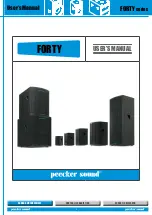
UPTURNED T SERIES
FORTY
series
SOUND REINFORCEMENT
ACOUSTIC RESEARCH
CONTROLLED RADIATION
User’s Manual
6
Generally speaking, an amplifier whose power is lower than the transducer’s
power tolerance (“undersized” amplifier) does not guarantee transducer
protection unless a limiter is used. In fact, when input signals are high, even
an undersized amplifier can “square” the output signal, resulting in the delivery
of power exceeding the nominal rating of the amplifier and the presence of
time lapses with constant voltage which are particularly damaging to acoustic
transducers. The recommended Peecker Sound amplifiers for amplifying
passive models are equipped with an internal limiter (
anti-clip
) which prevents
the signal from being squared. If they are undersized, they thus provide a
strong guarantee against transducer breakage. To achieve maximum dynamic
performance, however, as explained above, we recommend using oversized
amplifiers and a PS266 processor whose limiter functions will limit the input.
7.2 Amplifier-speaker connections
The table below provides a summary of the wiring between the
Neutrik®
SpeakOn NL4
connector and the transducers inside the cabinet.
PIN 1-
PIN 1+
PIN 2-
PIN 2+
4008
Full Range
Negative
Full Range
Positive
---
---
4010MH
Full Range
Negative
Full Range
Positive
---
---
4012MH
Full Range
Negative
Full Range
Positive
---
---
4015MH
Full Range
Negative
Full Range
Positive
---
---
4030MH
Full Range
Negative
Full Range
Positive
---
---
Table 2: Wiring with Neutrik® SpeakOn NL4 connectors
7.3 Power cables
It is very important to use power cables of the appropriate length.
The length of the cable can cause significant impedance and, as a result,
lower the quality of the audio signal as well as alter the
dumping factor
of the
amplifier-speaker coupling.
The table below shows the recommended power cable lengths for different
transducer impedance levels.
Maximum length
CSA duct
4 Ω
8 Ω
1.0 mm²
11 m
22 m
1.5mm²
17 m
34 m
2.0 mm²
22 m
44 m
2.5 mm²
29 m
58 m
4.0 mm²
44 m
88 m
6.0 mm²
66 m
132 m
Table 3: Comparison between CSA duct size and maximum cable length with different loads
8. ACTIVE LOUDSPEAKER SYSTEMS
All the
self-powered
versions of the Forty Series contain a 500 W (@8
Ω) class D amplifier with switching technology as well as on-board DSP
(
Digital Signal Processor
) with 24-bit of word code and sampling frequency
of 96 kHz. The DSP has
2 presets
, selectable through a switch located on the
rear panel. In the DSP of every single model, the equalization and limiters
of each of the presets selectable by the user are factory-set according to
the frequency.
Everything is designed to produce the best possible sound with the
maximum SPL value, in complete confidence that the speakers or
amplifiers themselves will not be damaged.
Through the connection panel it is possible to link the signal connected
to the speaker input (signal Link), and
three
LED lights indicate system
operation (POWER), signal presence (SIGNAL) and limiter operation
(LIMIT - a single LED indicates clipping of both the converters and the
power module) in turn. Volume control (LEVEL) is through a potentiometer.
Connection to the power supply is through a
Neutrik® powerCON
connector and a fuse located above it provides additional protection.
Figure 8. Active speaker rear panel
8.1 On board amplifier technical data
4012MH/A - 4015MH/A - 4030MH/A
Input connectors
max +10 dBu - XLR
Rear panel indicators
LED - power, signal, limit
Input impedance
12k Ω unbal., 24k Ω bal.
DSP processing
24 bit/96 kHz; 2 selectable preset
Output power rating
500 W (@8 Ω)
AC power connector
Neutrik® powerCON
AC voltage
115 or 230V ~ 45/65 Hz ± 10%
Table 4: Active speakers technical data
8.2 Presets
Amplified speakers can operate in two different modes -
Mode A
and
Mode B
.
As far as full-range upper modules are concerned, the two operating modes
are related to whether or not there is a subwoofer. In
Mode A
, the high-pass
filter frequency (HPF) cut is around 40 Hz. This mode should be used when
there is no subwoofer.
Mode B
should be selected if the full-range speaker is
complemented by a subwoofer for the reproduction of low frequencies. In
this mode, the high-pass filter frequency is around 90 Hz.
As far as subwoofers are concerned, the two operating modes allow a
choice, according to “taste” or to the type of installation, between two
different low-pass filter frequency cuts, so that the low frequency band
can have an extension of up to 86 Hz or up to 106 Hz.








